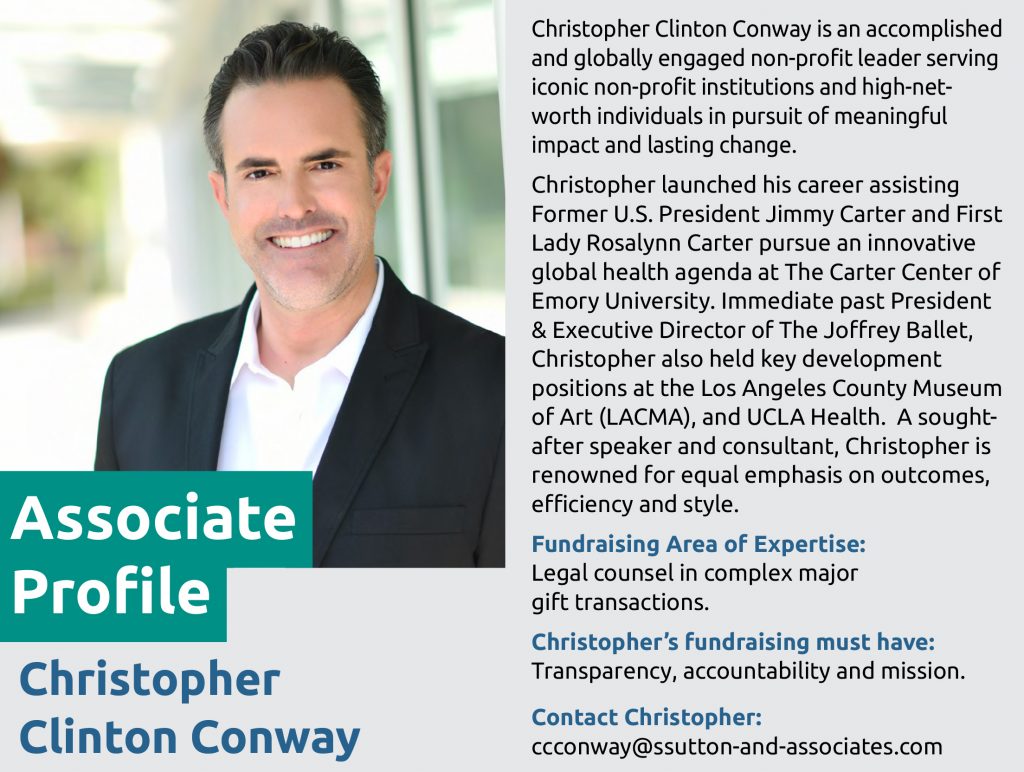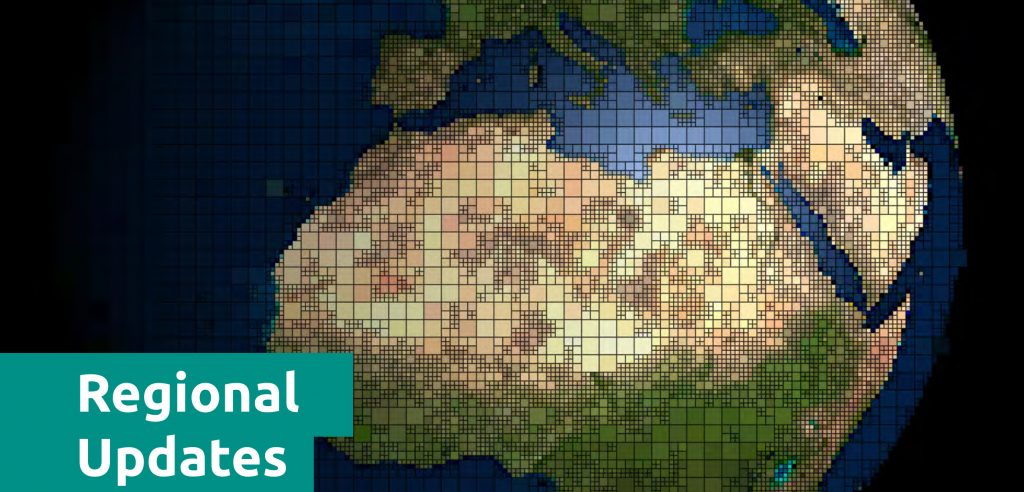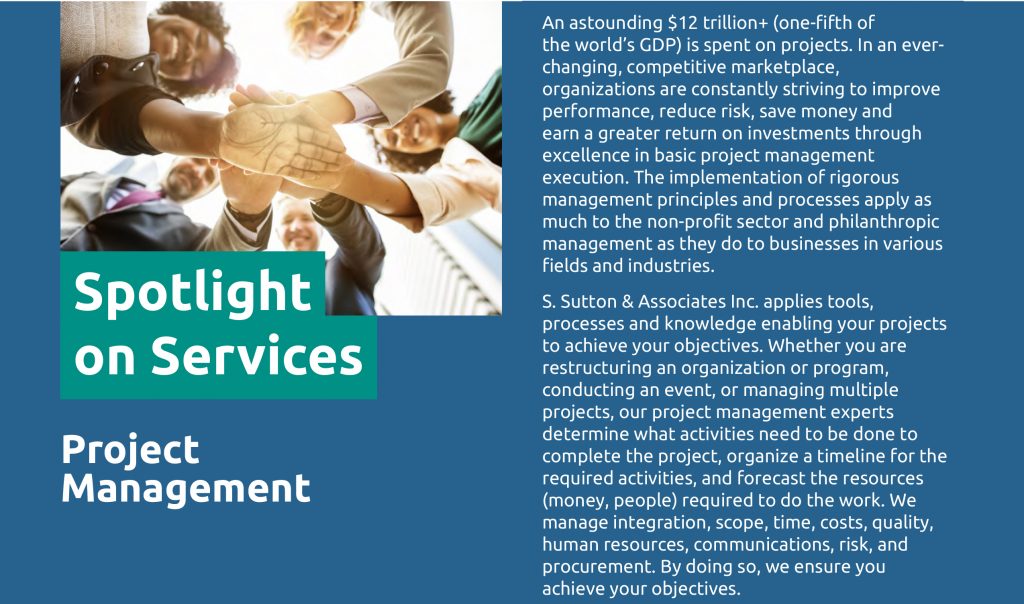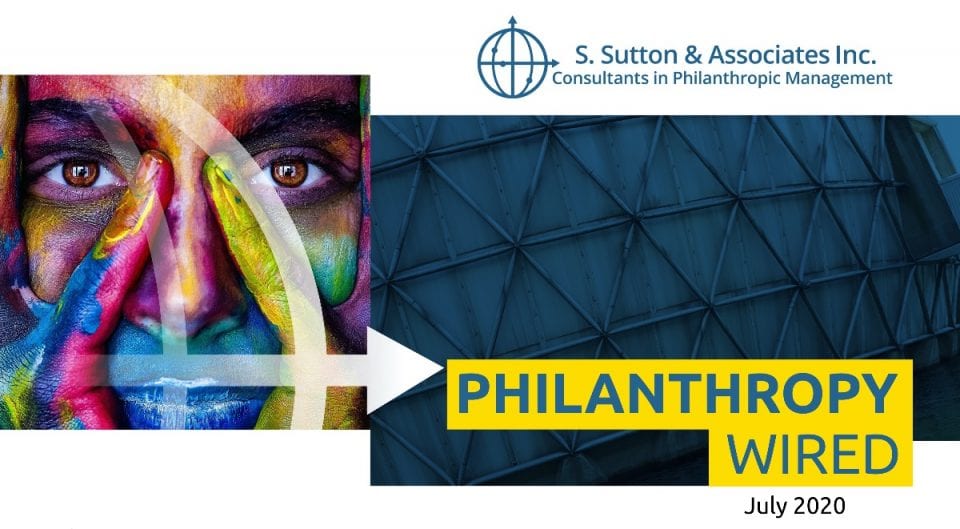
Welcome to the inaugural July 2019 Philanthropy Wired Newsletter! I am honored to serve as the Principal of our diverse and talented organization. As we begin the third quarter of 2019, we wanted to take our communications in a new and exciting direction. To connect with our growing number of subscribers, clients and Associates, we are rolling out a whole suite of communications products, including a monthly newsletter, LinkedIn articles, new content on the Insights section of our website, and biweekly emails designed to keep you informed and engaged with the latest news and updates.
Speaking of new ideas, I would like to bring three to your attention. The contemporary concepts of New Power, Next Generation-Enterprise and Blitzscaling have created a contemporary “Trifecta”, informing fundraising strategy, constituent mobilization, resource allocation, strategic and campaign planning, how gift pyramids are structured, gifts are made, and success is achieved. Maximizing the impact you or your organization has upon the world has entered a new dimension.
For more on the “Trifecta” please see my recent thought leadership article posted on LinkedIn.
Philanthropy Wired is designed to give our clients and Associates a 360-degree perspective on the evolution of philanthropy, our firm and the amazing talent in the field, all through the lens of the “Trifecta”. To say we are living in interesting times is an understatement, but disruption has taken on a new meaning and represents an inflection point that enables all of us to make an impact.
We welcome your thoughts, feedback and ideas as to how this platform can help you work, learn, grow and contribute.
Sending all good wishes to you and yours,

Susan Sutton
Principal, S. Sutton & Associates Inc.

Wired for Compassion:
The Millennial Impact on Philanthropy
The world of philanthropy is undergoing an e-revolution, one which is being powered by the millennial generation. Academic literature and proprietary research has demonstrated how millennials on average earn less than baby boomers, however donate at a higher rate than their predecessors. Reasons for this may be due to the ease of utilizing digital platforms and apps in order to give, as fuelled by the rise of mobile phones and other smart technology, online banking, and the use of social media to share information. The 2013 Millennial Impact Report has indicated that 80% of millennials use their smartphones to read articles and emails from non-profits and would prefer if organizations have a mobile optimized website. Ensuring information is digestible is key to millennial engagement. Furthermore, crowdfunding platforms like ‘GoFundMe’ are easily accessible via a computer or mobile app, and allow quick donations.

Many millennials in the workforce believe it is their responsibility to create change through fundraising for a cause, and are finding non-profits through their work online.
While they may lack financial resources compared to their older counterparts and are unable to make one-time large gifts, they appear to engage in monthly giving. Monthly giving could assist organizations in maximizing giving from younger donors, while also playing a part in donor retention. Regular monthly giving offers a key opportunity to build a long-term relationship with a future large-scale philanthropist. Last, for younger generations, philanthropy entails more than volunteering time or donating money. The 2013 Millennial Impact Report also emphasizes the benefit of tapping into youth connectedness through peer-fundraising initiatives.
Instagram – a favourite among the millennial community has introduced a ‘Donate’ sticker on its ‘Stories’ feature, which can now be used by organizations to receive gifts with a click of a button. For younger generations, philanthropy entails more than volunteering time or donating money. Whether a young founder of a start-up is determined to use their company’s technology to provide a solution for a social problem or an analyst at a hedge fund using social media in their spare time to create hype around a cause, millennials are seeking ways to leverage their expertise and connections to improve society.




— Canadian McMaster University recently announced a legacy gift of $100 million CAD by Charles and Margaret Juravinski to endow the Juravinski Research Centre, providing up to $5 million a year to the university, Hamilton Health Sciences and St. Joseph’s Healthcare in support of research in cancer, mental health, respiratory care and diseases of aging.
— A report from Fidelity Charitable indicates that millennial entrepreneurs tend to give and volunteer more than older entrepreneurs. More than 80% of millennial entrepreneurs consider giving a very important activity, compared to 57% of Gen Xers and 48% of baby boomers.
— The Parker Institute for Cancer Immunotherapy, JDRF, and the Leona M. and Harry B. Helmsley Charitable Trust have launched a $10 million research initiative. The initiative will focus on finding links between certain cancer treatments and insulin-dependent diabetes.
— Five key trends in 2019 are shaping Mexico’s philanthropic direction. These include non-profits benefiting from an increase in volunteering, women’s empowerment remaining a primary social concern, the importance of non-profits continuing to work locally with indigenous communities and the value of collaboration between non-profit organizations in responding to natural disasters. Lastly, online giving and crowdfunding continue to grow, bringing both challenges in transparency and accountability, while providing opportunities for a diverse stream of donors and funding.

— European Fundraising Association’s (EFA) flagship annual event, Skillshare, will take place in Oslo, Norway this year on November 21-22. EFA members, observers, associates and invited guests from the European fundraising community will come together for exchange, learning and networking.
— During 2018, donations to associations and foundations in France declined for the first time in a decade. Two key contributing factors for this decline included the change to the tax system from the ISF tax on wealth to the new IFI property tax and the increase in the generalized social contribution tax charged to retirees, which limited their disposable income for donation contribution.
— The Fundraising for Impact report survey of over 100 charities based in the UK reveals that despite concerns over economic uncertainty and its effects on donors’ disposable income, UK charities still rely on fundraising. To ensure gifts, non-profits are proactively working to improve the experience of current supporters and attract new donors, and even predict a 10% growth in contributed income over the next three years.

— The GlobalGiving non-profit community’s predictions for philanthropy in 2019 centre around two themes; that community leaders recognize the value of collaboration and that people from around the globe continue to strive for organized action on climate change.
— Community-led development (CLD) and community-driven development (CDD) are critical to empowering community builders in Nigeria in 2019 and beyond. Community-led development focuses on a community working together towards a shared vision to lead and
learn from local activities to achieve economic growth. Community-driven development is a grassroots-based approach, which shifts power to community groups, enabling them to make decisions about resource allocation.
— Ugandan donors cited two major reasons they donated funds to an initiative focused on raising funds to mentor disadvantaged student interns in Uganda; the importance of the cause and the confidence that their gifts would go to the cause.

— Non-profit organizations in China have grown from around 4,000 in 1988 to 816,000 in 2017. Despite this impressive growth, the non-profit sector’s contribution to China’s economy has no system of measurement making the non-profit sectors’ contribution to the economy unclear.
— Cambodians are taking a grassroots approach to resolving the issue of pollution and illegal fishing in the waterways around their Islands. Led by a coalition of community groups, non-profit organizations, and the Cambodian authorities, 40 community
fisheries (CFi) organizations patrol the Cambodian coast, aiming to identify and protect fragile marine areas, address threats to the environment (such as over-fishing or the use of prohibited fishing nets), and assist local communities with their waste management problems. The success of these CFis have led the Cambodian Authorities to request a similar model be applied in other communities around Koh Sdach Island. Fauna & Flora International (FFI), a non-profit environmental organization, is working with the Cambodian authorities to establish a second protected marine reserve.

— Social entrepreneurs in the Middle East are striving to provide access to clean water and basic education, improving skillsets in response to unemployment, and tackling the issue of food security. People are trying to find solutions to issues that governments are not solving. Social entrepreneurs must work even harder due to lack of funding. While developing good government relations is critical, the government
often views non-profits as competitors to the state, leading to interference that hinders scale and impact. There is no definitive or legal registration status for social enterprises in many parts of the region, but a vast amount of regulations must be met. Ultimately, most end up establishing themselves as a for-profit company and do not rely on grants and other forms of donations.

— South Asia is home to many successful initiatives to empower rural women. The World Bank has assembled a platform for women’s economic empowerment that consists of more than 25 community organizations and women-led enterprises. The World Bank in collaboration with the government of India created the collaborative partnership a decade ago in response to the effects that climate change has had on the rural poor with creative, entrepreneurial solutions. A planned three-day regional conclave includes over 5,000 handcrafted accessories, clothing, decorative items and farm-based products created and produced by women’s groups and enterprises in Afghanistan, Bangladesh, Bhutan, Nepal, and 13 states across India. Local producers and industry experts discuss how to take their produce to regional and global markets.
South Asian practitioners also review regional approaches for bringing in private sector investment. India’s most prominent fashion designers use fashion shows to highlight South Asian weavers, embroiderers and artisans in support of local economies.
— The Nepali government has removed the minimum threshold for most types of foreign assistance in an effort to streamline all financial assistance as grants or loans and maximize aid to tackle large development projects. Key priority areas for the government include: environmental protection, climate change, sustainable development efforts, rural infrastructure, social development, agriculture modernization, education, clean drinking water and human development.

— Peruvian youth are providing a unique model of civic engagement. Seeing many children living in poverty, a child decided to help teach them how to save by registering his own bank with help from a student prize in his local town. He now has 2,000 clients between the ages of 10 and 18 to whom he offers loans, microinsurance and other financial services. Clients can withdraw money from several cashpoints (once they reach certain savings goals) using personal bank cards to monitor their balances online.
Children are also encouraged to collect plastic bottles, used schoolbooks and old newspapers in their homes and bring them to a kiosk at their school in exchange for money credited to their bank accounts. Peru’s environment ministry, which has made home recycling a principal campaign, appreciates the program. The bank recycles about four tons of material a month (of the 18,000 tons of solid waste per day in the country) and has kiosks in seven schools with more on a waiting list. The model is also in demand in the rest of Peru and abroad.
— 46% of donors prefer to give online with a credit or debit card, followed by bank or wire transfer. Minimal donations are made via PayPal, mobile apps and text message donations.
Increased access to online and mobile giving technology will likely cause a significant increase in these numbers in the coming years. 20% of donors are more likely to donate if offered a gift in exchange, while over 1/4 donate to natural disasters and 6% incorporate charitable giving into their will. Almost 2/3 of donors are more likely to trust organizations with the .org extension for website and email and approximately the same number are most likely to give repeatedly if regularly informed about the work the organization is doing and how their donation is making an impact.
Most are inspired to give by social media, followed by an organization’s website and email. Facebook has the largest impact on philanthropy (10% have used Facebook Fundraising Tools and 85% are likely to re-donate through Facebook), then Instagram (30%), followed by YouTube (8%). Phone calls, radio ads, and text messages have the least impact on giving. Donor privacy is critical with over 3/4 not wanting their contact information shared and more than 90% wanting their contact and financial information protected from data breaches.

— Young adults in Australia between the ages of 18 and 24 have made a significant impression in philanthropy. According to a recent report, they are volunteering more than older adults, more likely to participate in workplace charity, and more likely to support a range of causes such as helping children (the most popular cause in general in the country), disaster relief, mental healthcare, and human rights including LGBTQ+ rights. Over 60% of Australian donations are made to non-profits. Cash is the preferable mode of donations. While women are more likely to believe in the positive impact of charitability, men typically donate twice as much.
— Over 3/4 of non-profits in New Zealand are hosting cause, community, and educational events, including galas and fundraisers, networking opportunities, training and workshops, consumer classes, food and drink events, as well as arts and entertainment events. The greatest revenue comes from ticket sales, sponsorships, and grants or donations. Non-profits equally use social media (primarily organic posts, followed by Facebook or Instagram posts and display ads); email communications, and word of mouth or referrals to market the events. Because of so many events, non-profits in New Zealand are facing the most challenge this year in reaching new attendees, securing sponsors, and maximizing limited budgets.



The Green Party of the United States (GPUS) is an independent political party and federation of state parties associated with American social movements. When progressive politics in the United States was fighting for survival, in May 1984, a Green Movement Committee was founded with the aim of “the formation of a Green political organization in the USA”. Concurrently, a Green movement was taking root in Germany, and beginning to spread throughout the world.
Founded as a collection of green groups in 1984, the Green Party of the United States has made monumental strides in its four decades of existence. Since 1996 the party has run a national ticket in every presidential election. Nominee, Ralph Nader, received nearly three million votes in 2000 and, in 2012, Jill Stein received the most votes at that time for a woman in a presidential election in US history. Across the country hundreds of Greens have been elected at the state and local levels.
The Green Party of the United States is part of the global Green movement, sharing policies founded upon six universal principles including: Ecological Wisdom, Social Justice, Participatory Democracy, Nonviolence, Sustainability and Respect for Diversity.
As the exclusive fundraising consultant for the Green Party of the United States (GPUS), S. Sutton and Associates Inc. has worked intensively over the last year and is now turning attention to training local candidates, state and local Green Party leaders and key campaign volunteers via webinars, with an emphasis on best practices and tactics to achieve successful planning, strategy and execution of political fundraising and mobilization of constituents.

 Contact@SSutton-and-Associates.com
Contact@SSutton-and-Associates.com 420-737-921-492
420-737-921-492 410-245-0398
410-245-0398 647-969-8866
647-969-8866



 www.SSutton-and-Associates.com
www.SSutton-and-Associates.com